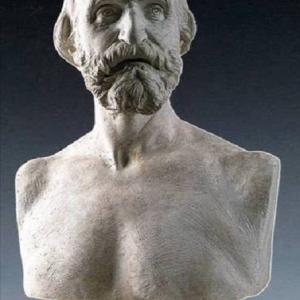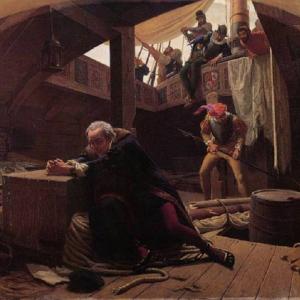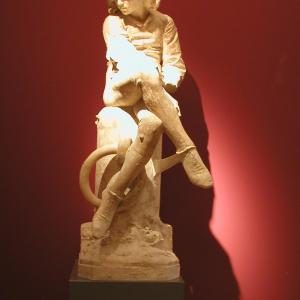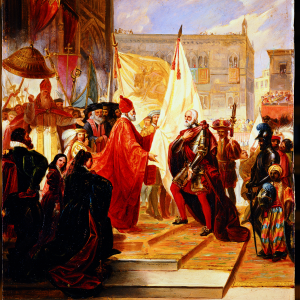The works displayed in the last exhibition space on the ground floor are dedicated to some famous figures of Genoese history and culture. Three works focus on the iconography of Columbus: the “Colombo giovinetto” by Giulio Monteverde, original plaster model from 1870 for the marble figure now in the Castello D'Albertis Museum in Genoa, dressed up as a troubadour, interpretation of the myth, in which the young Columbus, seated on a pier looking to sea gazes at the horizon with dreamy eyes, presaging perhaps his great enterprises; “Cristoforo Colombo alla corte di Spagna” (1862), a watercolour on paper by Francesco Gandolfi, preparatory work for the fresco of the old hall of the city council in Palazzo Tursi, historical seat of the Municipality of Genoa and today a museum; “Cristoforo Colombo di ritorno dalla scoperta dell’ America” (1863) by Lorenzo Delleani (Pollone 1840 -Turin 1908) a work with a theatrical flavour which narrates, once again with troubadour costumes, the return of Columbus to Spain in chains, like the monkey close to him, because accused after the third voyage, of having taken possession of the crown's assets.
In the same area are displayed portraits of the famous violinist Nicolò Paganini, produced in 1836 by Giuseppe Isola (Genoa 1808-1893) and another by Pelagio Palagi (Bologna 1775- Turin 1860); Also by Isola is the painting dedicated to the Genoese admiral Andrea Doria who rejects the crown of Genoa, a sketch for the curtain of the city’s theatre of the same name, which no longer exists. The painting by Camillo Pucci (Sarzana 1802-1869) also refers to Charles V's admiral, Andrea Doria this time receiving the naval ensign, 1835, this painting comes from the collection of the Duchessa Di Galliera.
In memory of the figure of Giuseppe Verdi and his long stays in Genoa between 1866 and 1900 is the plaster model of Giulio Monteverde for the bronze bust of 1902, preserved in the Rotonda Monteverde del Senato at Palazzo Madama in Rome.
On the staircase there are two very important paintings: the gloomy "Ritratto di Donna Giulia Lavaggi Centurione Scotto", made in 1884 by the famous German symbolist painter Franz von Lenbach (Schrobenhausen 1836 - München 1904) who undoubtedly made use of a photograph of the noblewoman, and “Rose Bianche” by Pietro Gaudenzi (Genoa 1880-Anticoli Corrado 1955). This portrait, dedicated to his wife Candida Toppi.
Busto di Giuseppe Verdi, 1902

Busto di Giuseppe Verdi, 1902

Busto di Giuseppe Verdi, 1902

Busto di Giuseppe Verdi, 1902

Christopher Columbus returning from the discovery of America

Christopher Columbus returning from the discovery of America

Christopher Columbus returning from the discovery of America

Christopher Columbus returning from the discovery of America

Young Columbus

Young Columbus
Young Columbus

Young Columbus
Andrea Doria receives the battle flag

Andrea Doria receives the battle flag

Andrea Doria receives the battle flag

Andrea Doria receives the battle flag





